After a dreaded double-and-a-half travel-day (overnight train from Mumbai to Jalgaon, then an overnight bus from Jalgaon to Ahmedabad followed by a six-or-so hour bus from Ahmedabad to Udaipur), we were about three days overdue for showers, and maybe even a change of clothes. Well, definitely showers anyway.
India is not the cleanest country I’ve traveled in (that’d be squeaky Switzerland, or parts of Japan), and feeling at home here may require a period of adjustment for multiple reasons (this list isn’t meant to disparage India outright – just being honest about my experience):
- Stray dogs and ownerless cows roam the streets of most cities and towns. You’ll see roaming goats and wild pigs as well, even in heavily populated urban areas. Oh, and there are often pesky and aggressive wild urban monkeys too for some reason.
- Accordingly, the waste of said animals can also be found in the street and in other public areas. Watch your step (this becomes second nature).
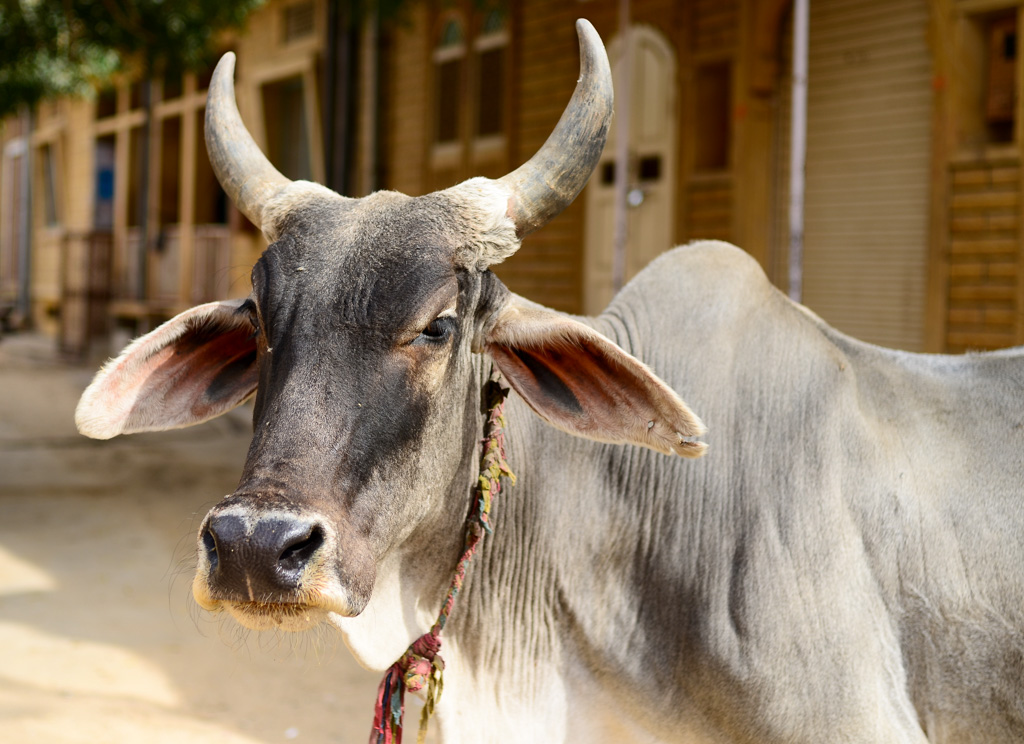
urban cow.
- It’s perfectly acceptable for any man to piss on a wall (or not on a wall) in any urban/rural area, at any time, or a child to squat in the middle of the market.
- Men hack up phlegm and spit into the street with near constancy.
- Motorbikes, autorickshaws and cars have the right of way over pedestrians, no matter how cramped the tiny alleyway. So prepare to get pushed off the street and into the dust, trash or open sewer to avoid getting nicked by handlebars, side mirrors or hot exhaust pipes.
- Air quality is just not good in the big cities, no matter what anyone tells you. Delhi’s officials maintain that Delhi sometimes has intense “fog” problems this time of year – sometimes so bad that it grounds flights or makes others difficult to land. Fog, eh. Bangalore has a pretty terrible reputation as well, and many small towns seem pretty hazed over as well.
- Most overnight bus berths you’ll hire have pads and sheets that may never have been laundered since purchase.
- Public bathrooms/latrines almost never have soap or towels. Carry your own if you need.
- Done with your plastic chai cup? Throw it in India’s natural garbage can: the street. I don’t feel comfortable doing this, but it seems to be the way of the world here. It can be pretty difficult to find trash cans as well – there’s no guarantee that your conscientious effort to dispose of your garbage properly will keep it from getting dumped in the gutter anyway by the person that empties the waste bins.
- I don’t know if this makes the streets cleaner or dirtier, but the wandering ownerless cows consume the piles trash that gets dumped on the street every day and night – including non-food items like plastic bags, cardboard boxes, and other non-organic waste. This is not only bizarre and disgusting, it’s tantamount to animal abuse to India’s most holy of animals. Argue with me on this, go ahead. These animals deserve better. And no, I don’t understand all of India’s problems nor can I offer solutions, but this is a problem no matter how you look at it.
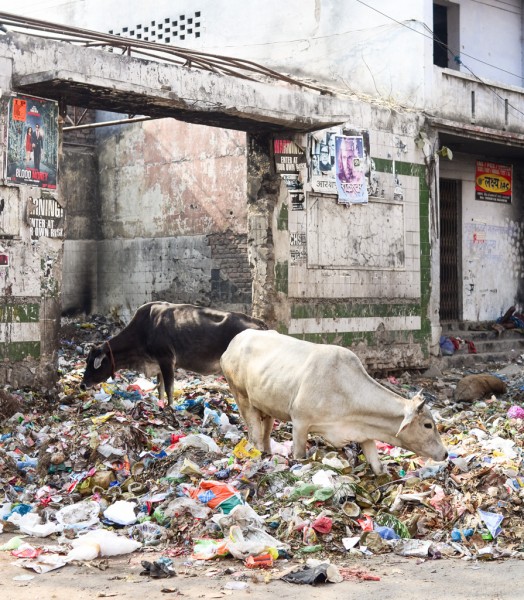
cows consuming trash in the street in Varanasi.
We arrived in Udaipur around 2:30 PM on January 28th, jumped into a rickshaw to the Lal Ghat area of town (40 rupees) and booked a room at the first guesthouse we saw. It set us back 300 rupees a night for a concrete floor, porous walls that let the cold night air and motorbike horns in, dirty sheets and a bathroom that leaked onto the bedroom floor so much as to create the 10 sq ft “Lake Matt & Kelly” (which persisted for our entire 2-night stay), and a toilet that needed about three flushes for usefulness.
Sound horrible? It was, but it was also only six bucks, split between two people. Three dollars a night – the cheapest place I’d ever stayed at the time. The water from the fire hose-style shower head was warm, and there was no sign of bedbugs. Why worry? We had to sleep in our warmest clothes in bed both nights – the covers weren’t enough to fend off the cold.
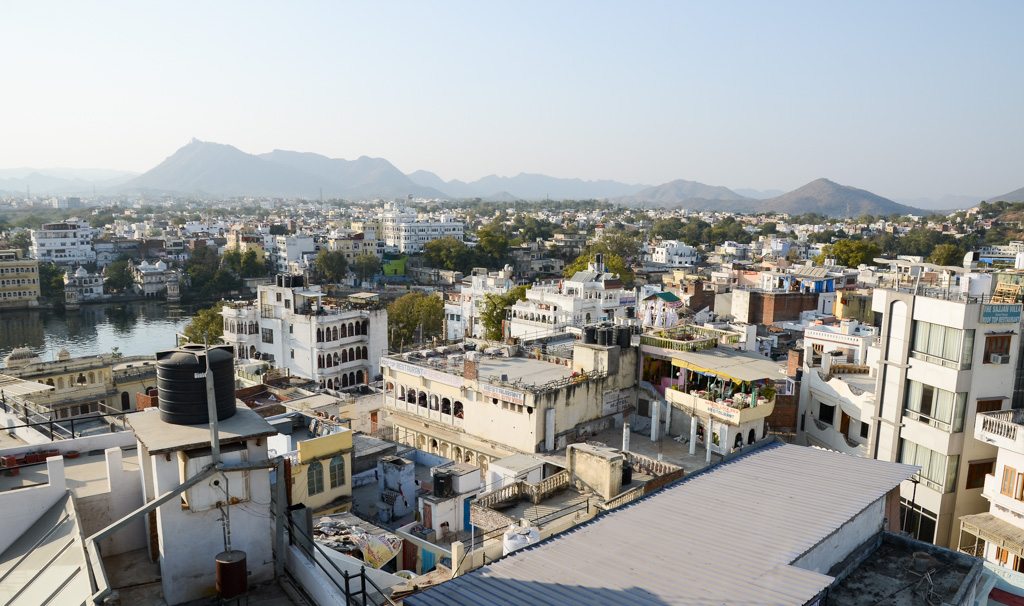
Udapur from our guesthouse building.
Udaipur is an accessible, fairly pretty place. The narrow streets of the old city run up against scenic Lake Pichola, and nice views are to be had of the City Palace and the Jagniwas Island palace (18th century), which has been converted into a luxury hotel. Most locals were friendly as well, even though this town gets so much tourism that I would imagine they’d be sick of people like us by now.
It seems like every restaurant in Udaipur is on a rooftop, so that’s likely where you’ll find yourself each evening. The town shuts down early and there isn’t much of a party scene, but it doesn’t matter anyway – most guesthouses have something like an 11:00 PM lockout policy, so you’ll need to be back in the room before it gets too late.
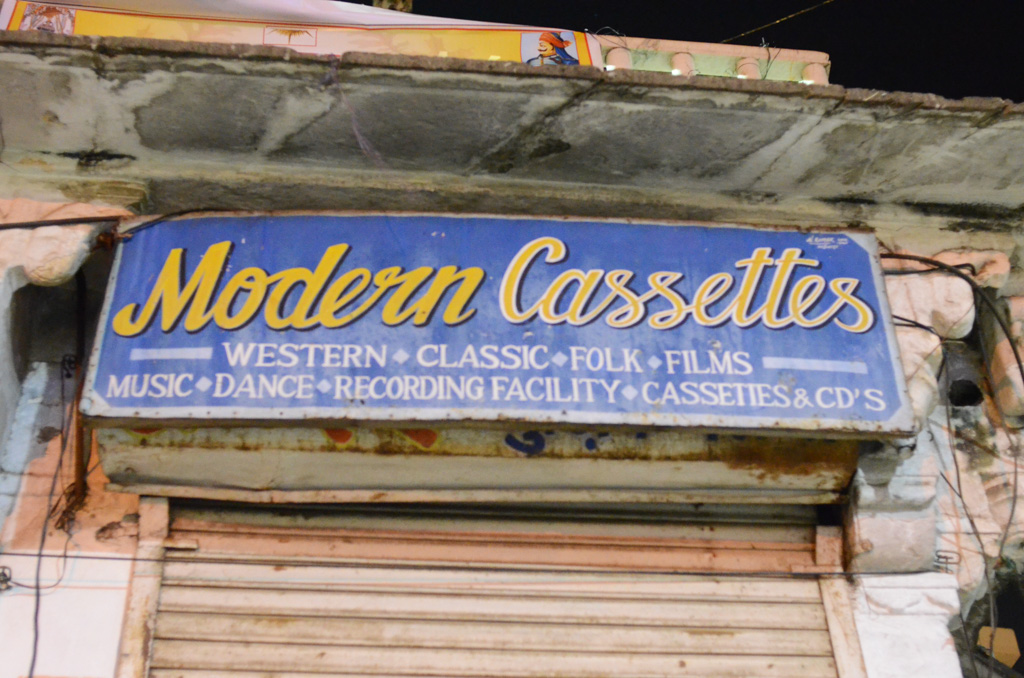
anachronisms now in stock.
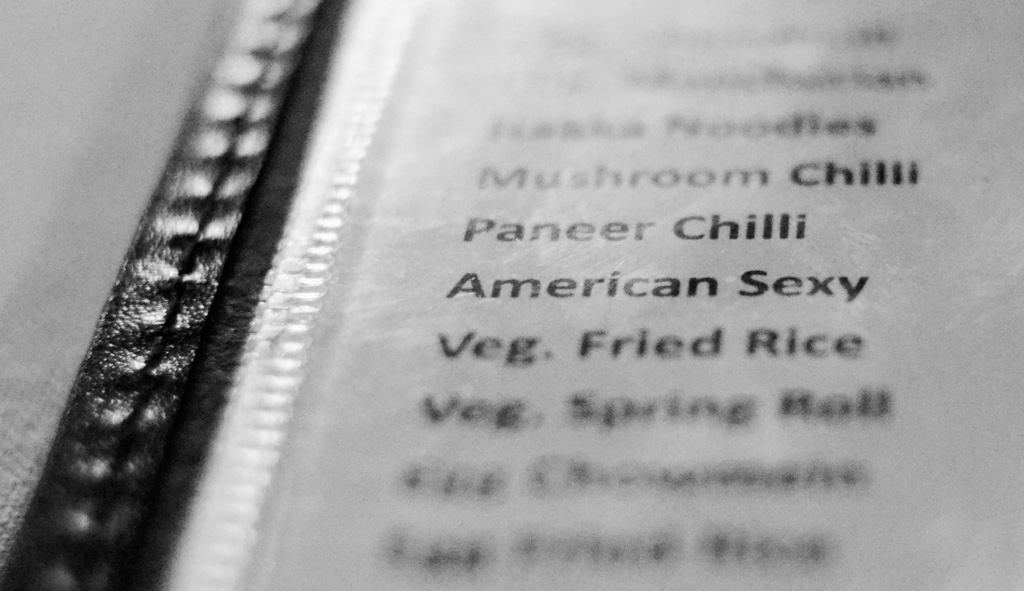
what’s for dinner? menu of a rooftop restaurant in Udaipur.
Part of the film “Octopussy” was shot in Udaipur, and the town just won’t let it go. Many of the guesthouses screen the film every night, and advertise this as if your average tourist would drop everything for some James Bond. That’s why you came to India, right?
At home, I thought I was capable of eating saucy Indian food forever. But by Udaipur and after plate after plate of gravy-like curries, I had a hankering for some fresh, uncooked vegetables/ In Udaipur, my prayers were answered. We discovered a new restaurant on the west side of the lake with various organic salads, fresh-made soups, and friendly young owners with interest in sustainable agriculture and turning local produce into tasty meals. I am restored! The worth-mentioning restaurant is named Millets of Mewar, and was not in the 2011 Lonely Planet India. I suspect that it’ll be in subsequent editions.
A boat ride around lake Pichola is apparently one of the things to do in Udaipur, though I found it fairly pointless. We boarded a boat just south of the City Palace, got taken on a 30-minute loop of the lake with no absolutely no description and no stops, and were promptly returned to the dock 200 rupees poorer, each. The chances for views and photos of the City Palace and Jagniwas Island were limited by the boat-full of other tourists, the non-stop motoring of our pilot, and the nasty angle of the sun at the time. If you want a better view of the lake, it may be worth looking into hiring a private boat, though this would inevitably increase costs.
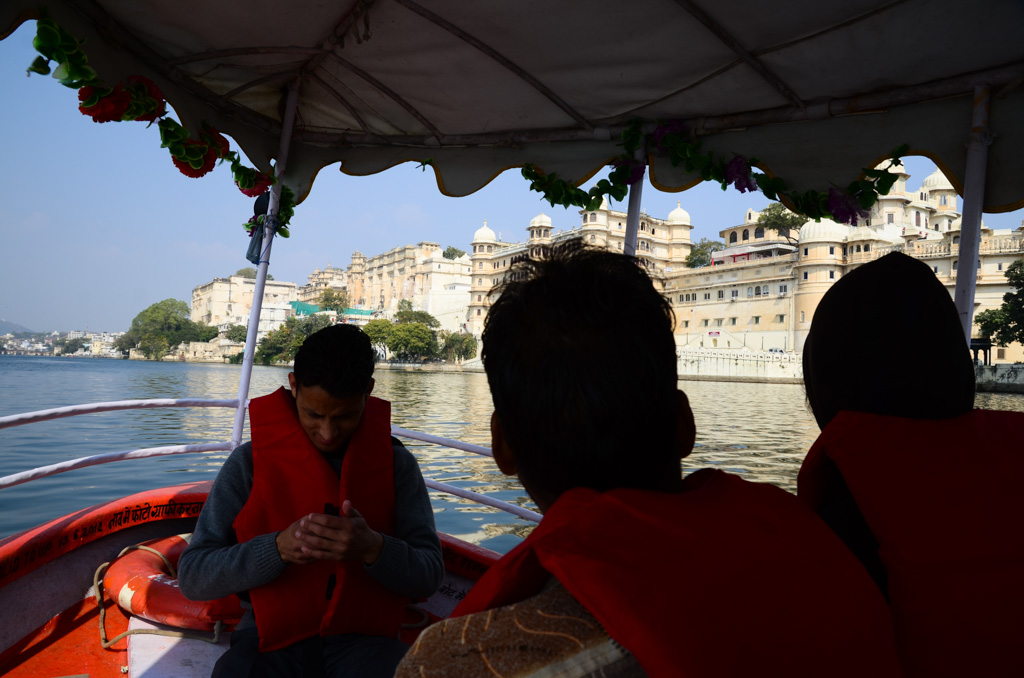
My forgettable view on our Lake Pichola boat ride. Udaipur City Palace, conveniently located behind tourists heads.
We also made a stop at Udaipur City Palace, which was fairly interesting and offered nice views of the city. Total admission was about 300 rupees between three subsequent ticket booth stops at the entrance (yes, three, for some reason) plus an annoying 200 rupee camera fee.
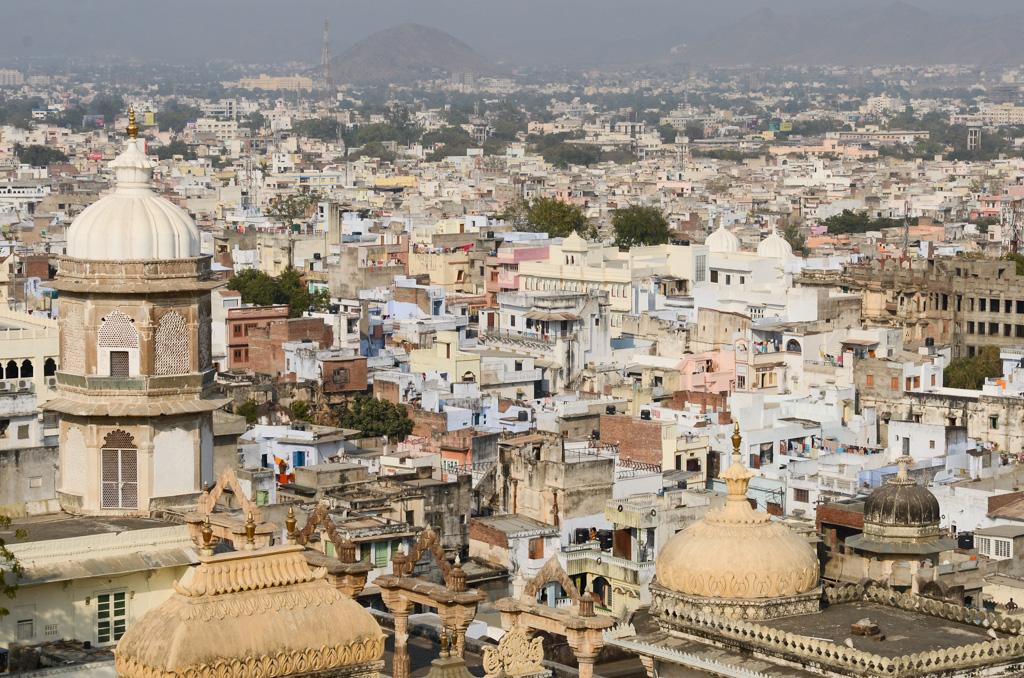
a hazy view of Udaipur from the City Palace.
One full day was more than enough to see Udaipur. Our desired next destination was the blue city of Jodhpur, but there were two stops we wanted to make on the way there – Kumbhalgarh, a large fort, and Ranakpur, a large Jain temple complex made of white marble. I made the choice to splash out a little on a long distance taxi ride so we could do a lot with the next day. Our one-way taxi ride was a splurge at 2500 rupees + 300 tip, and took pretty much all day including our two stops.
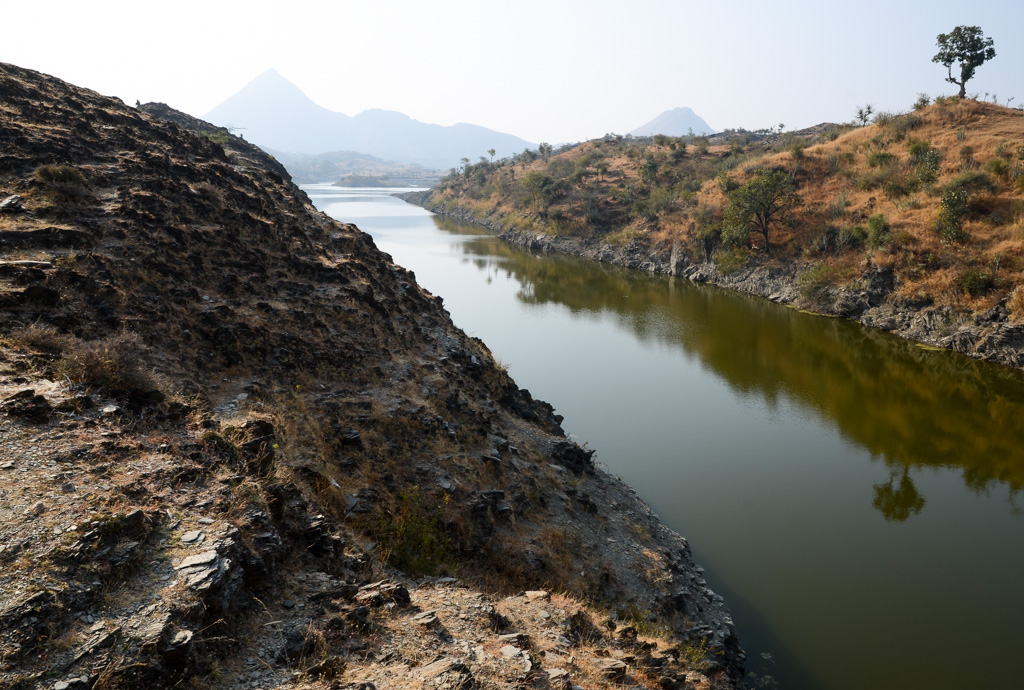
a rocky Rajasthan landscape.
The Mewar fortress of Kumbhalgarh was built in the 15th century and further enlarged in the 19th century. Built on a hilltop, it boasts over 36 km of continuous walls, claimed to be the second longest continuous wall after only the Great Wall of China. The walls of the front gate are 15 feet thick.
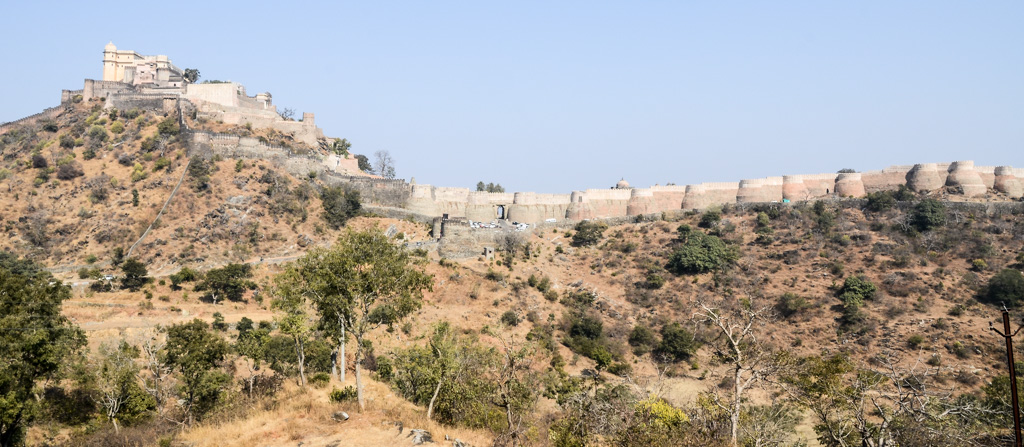
A festival was taking place the day we visited, so after climbing to the top of the fortress for the vista, we ambled down to see the music and dance taking place below. Pallavi, a state-recognized child star of 2010 (according to the posters at the festivals, anyway) was getting down something FIERCE on the astroturf to a tight Rajasthani drum section.
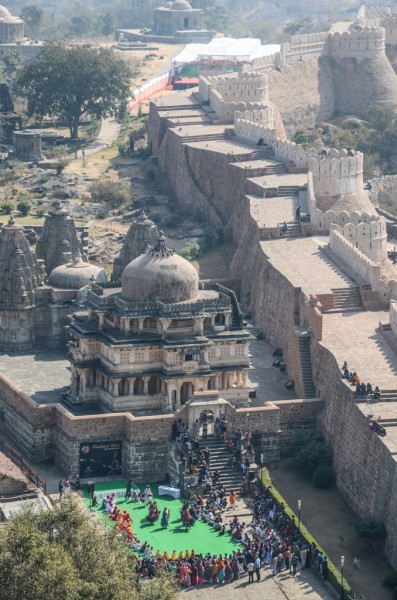
A very hazy day at Kumbhalgarh, from behind (and above) its massive walls.
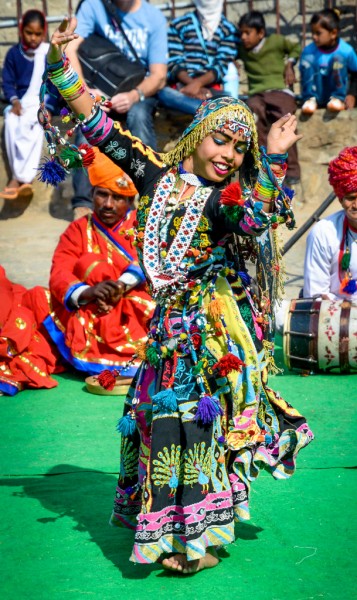
Pallavi breaking it down at Kumbhalgarh.
Soon it was time to go, and we loaded back into our taxi for onward travel through the dry, hilly landscape toward Ranakpur.
Ranakpur was quite beautiful and worth a couple of hours visit as well. Photos of the exterior of this place don’t do it justice – you need to get inside, where the carved pillars and domed ceilings are intricate and really quite remarkable.
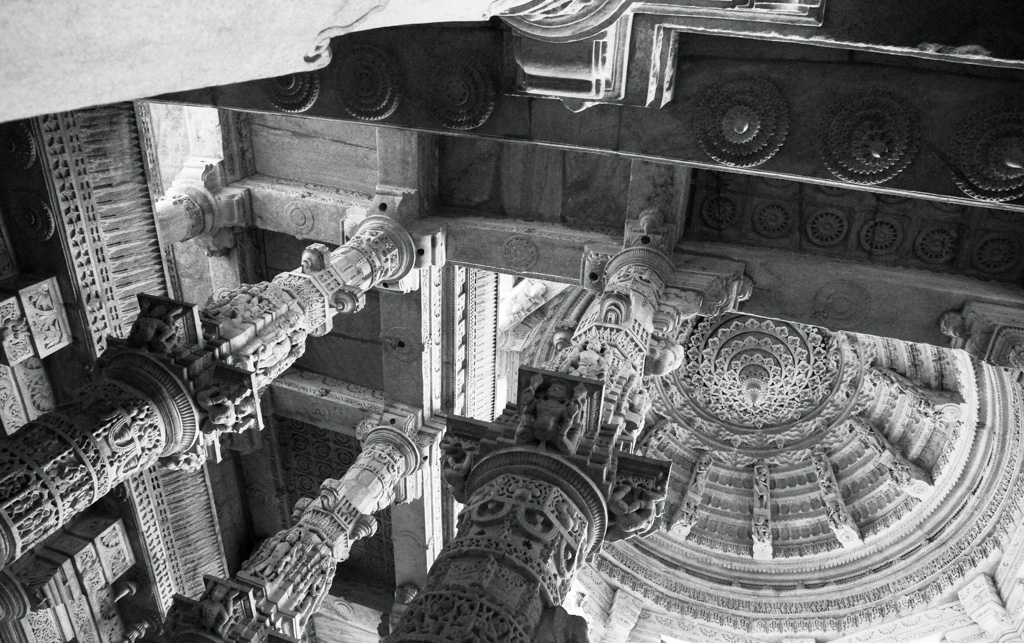
Up-angle inside one of Ranakpur’s many domed ceilings.
Shoes aren’t allowed inside Ranakpur, so barefoot shuffling of one’s feet on the cool marble is de rigeur. Also not allowed inside: leather purses, leather belts or anything else that could have been made from a harmed animal. Menstruating women are requested to stay outside as well – it’s posted in plain language outside the front door (which I still feel weird about, but it’s a Jain thing I suppose).
Our taxi driver was quite nice for the majority of the time, but was also quite interruptive – especially when Kelly was talking. No conversation she began/continued was so sacred that he wouldn’t override it with important comments like the prideful “THIS CAR IS A 2009” and the explosive “SIR, DO YOU LIKE MONKEYS?” This has become a bit of a theme – that is, men addressing me instead of my female travel companion, and willfully interrupting her when she speaks. It’s a source of frustration for sure. Patriarchy!
From there, it was onward on dusty Rajasthani highways toward Jodhpur. We pulled in after dark – maybe not an advisable arrival time given that visibility wasn’t great on the freeway there at the time we traveled.
Touts surrounded our taxi upon arrival in Jodhpur (like usual in Rajasthan), but one person decided to help us instead of pitching to us – a bright-eyed middle-schooler named Himanshu. We told him what guest house we wanted to visit (Pushp Paying Guest House, a Lonely Planet recommended place with five or so rooms, hidden in Jodhpur’s narrow, winding alleys), and he walked us there out of goodwill, cracking wise the whole way (“I am a very funny guy!”). It was so odd to have someone in a city center treat us more like people and less like commercial targets that we almost didn’t know what to say. Thanks, Himanshu!
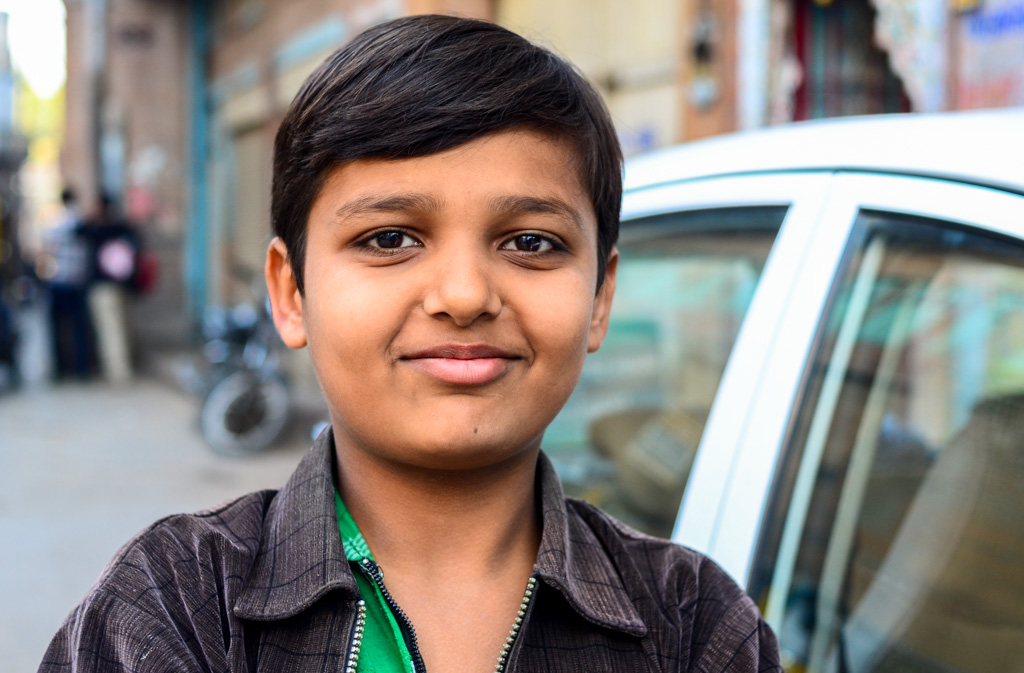
Himanshu.
Ours for the night was a nicely decorated room with a big concrete bathroom (that I cut my own hair in on night two with great success) and a fairly comfortable (though somewhat short In length) bed. A solid base of operations for 600 rupees a night, wifi included.
Jodhpur is worth a little over a day, in my opinion. There are only a few sights, including Merangarh fort, which looms 120m over the city and is worth a visit without question if you’re in town. The photos everyone takes of the painted walls of the blue city are likely from the vantage point of the fort, so if you’re looking to replicate said shot, do it from Merangarh. Two birds, one stone.
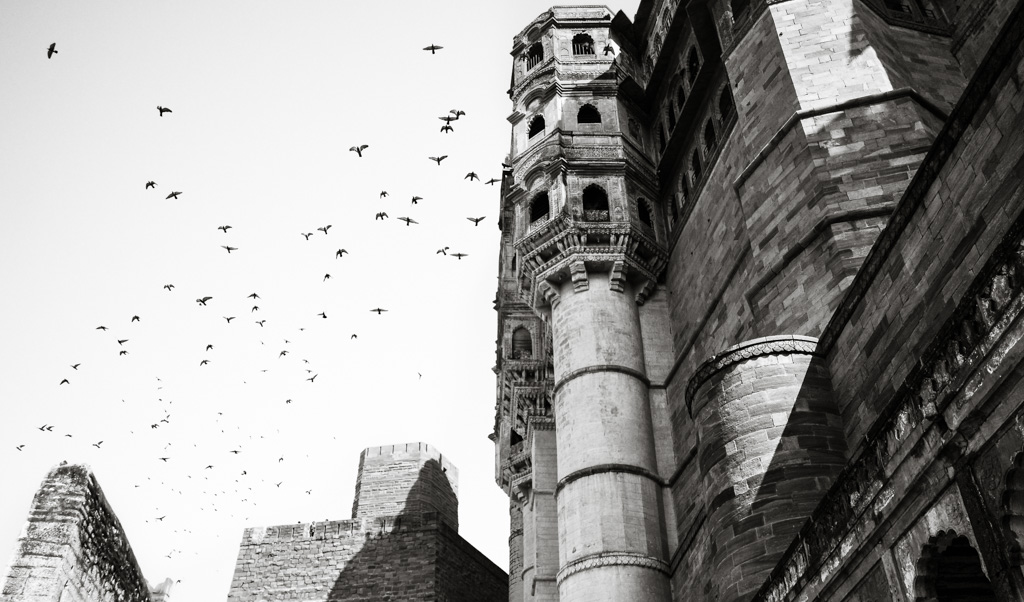
Mehrangarh Fort exterior walls and birds.
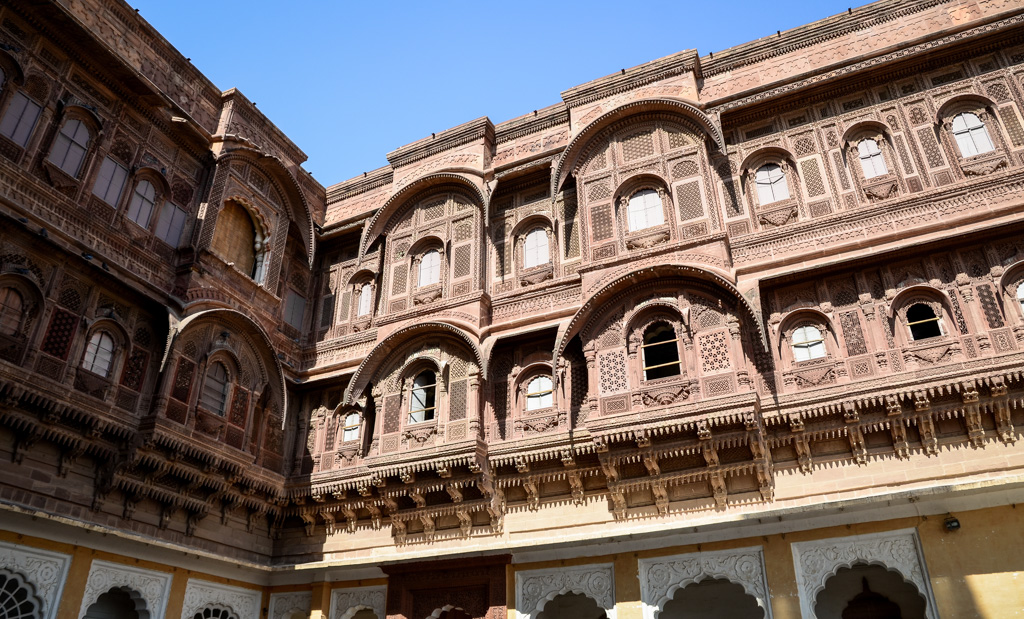
Mehrangarh Fort, haveli detail.
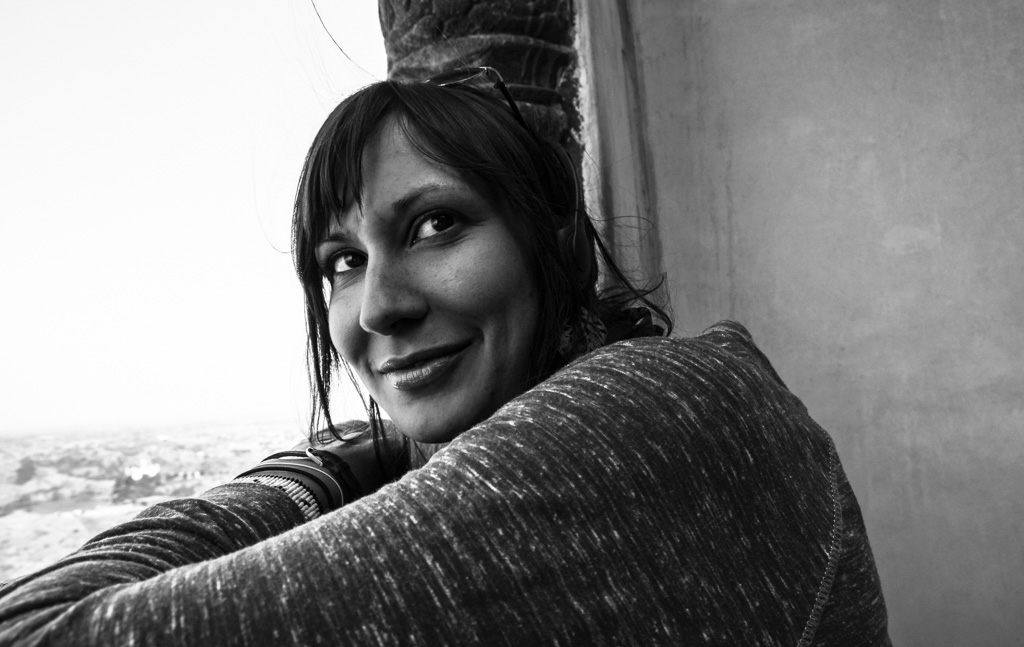
Kelly overlooks the blue city from Merangarh.
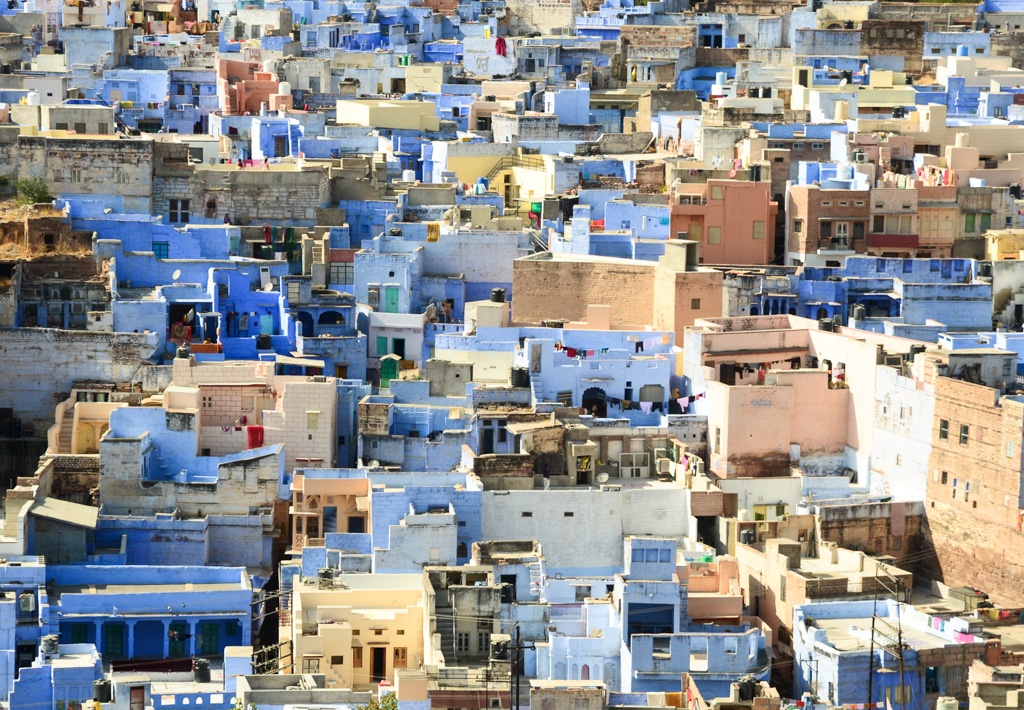
“blue city” detail.
Things were getting better. I was getting through my “India bewilderment” phase caused by jet lag, culture shock, endless hawkers/touts, car horns all day and night, insane traffic patterns and filth. Now, as I start to surrender myself a bit more, my outlook is improving. India is both coaxing and dragging the bad and good out of me – it’s just a wide breadth of experience, it can be exhausting, and getting to know this place requires patience.
NEXT STOP: Jaisalmer








Matt, your trip looks amazing thus far. Thoroughly enjoying reading about it!
Thanks Jess. I’m only 18 days in, too! Hopefully I can get another 2 months here, schedule permitting – it’s definitely affordable enough here to swing it.